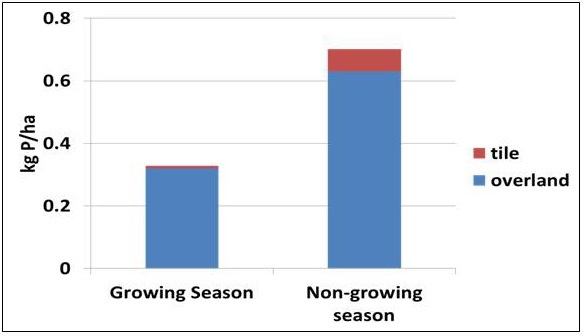Best management practices for phosphorus
Learn about phosphorus and best management practices to keep phosphorus in the field.
Algal blooms have been an issue in Lake Erie since the 1960s. The blooms, which are harmful to wildlife and humans, occur when phosphorus levels are high within the lake. These levels decreased during the 1980s and 1990s in part due to soil-conserving best management practices implemented by farmers, but within the last decade water quality monitoring has revealed an increase in dissolved reactive phosphorus (DRP). While current causes of the DRP increase are unidentified, experts believe increased rain events of more than one inch, fertilizer placement and legacy soil test levels play a role.
In most soils, phosphorus exists in one of four forms:
- inorganic mineral compounds with aluminum, iron, or calcium;
- associated with soil particles;
- soluble compounds dissolved in soil water; or
- in organic matter. From these four forms, most phosphorus exists as inorganic minerals strongly attached to soil particles.
In-organic phosphorus generally does not leach into groundwater, but can move into surface waters by soil particles during erosion. This occurs especially where the land has recent manure or phosphorus fertilizer applied but not incorporated. Soluble phosphorus forms can move off-field with runoff water during heavy rainfall or irrigation.
The 3 main ways Phosphorus (P) leaves the field are:
- wind erosion of soil particles where P is attached
- water erosion causing overland water flow, where P-attached soil moves with water, and
- in both overland flow and tile drain water as dissolved P.
The majority of P loss is occurring during the non-growing season portion of the year (Figure 1). Farming practices that leave soils unprotected during the non-growing season are the major cause of the P losses. During the growing season, phosphorus spikes have been measured in tile water after a heavy rain fall or after a dry spell in cracked dry clay soils.
Accessible image description for Figure 1
Two key categories of Best Management Practices (BMPs) for phosphorus are:
1) Phosphorus fertilizer
The only way to increase nutrient use efficiency and be able to make knowledge-driven rate decisions of fertilizer application rates is through soil testing. Soil testing is an essential part of crop management. Producers can help reduce the potential for phosphorus movement into water by applying phosphorus fertilizer only where needed and incorporated or applied below the soil surface. Manure applications should either be incorporated with light tillage or injected below the soil surface. These BMPs are broadly effective at reducing movement of phosphorus into surface water.
To reduce losses of soluble phosphorus under no-till systems, researchers found phosphorus fertilizers should be deep banded or placed near the seed. Deep banding phosphorus fertilizers reduced phosphorus runoff losses by 50 percent compared to broadcast fertilizer applications. The combination of reduced tillage and phosphorus placement below the soil surface will be effective in reducing phosphorus losses into surface waters.
2) Erosion control
Since most phosphorus in the field is strongly attached to soil particles, erosion moves both soil and absorbed phosphorus into surface water. Chemical equilibrium reactions that occur in water that can cause a certain amount of absorbed phosphorus to be released from the soil particles and into the water as soluble phosphorus. Farmers are also concerned about P loss because it indicates a loss of soil from their fields. While the 1 lb/ac loss of P may seem insignificant, the associated soil loss is not. Assuming that total P (all forms of P) in a soil is 500 ppm (average for temperate soils), then 1 lb/ac P is equivalent to 1 ton/ac of soil. In the short term, soil loss has financial implications with loss of nutrients which have to be replaced and yield loss. In the longer term, losing substantial amounts of top soil loss will impact crop production from reduced water and nutrient holding capacity.
Erosion control BMPs focus on reducing field runoff. Examples are installation of water control structures (grassed waterways, buffer strips, permanent berms, etc.) , strip cropping, Organic matter additions by 30% residue cover and residue returned to the soil, sub-surface drainage, overwintering cover crops (preferably alive but also undisturbed dead), more crops in rotation, and reduced or no-tillage.
No-till farming methods can reduce soil erosion by up to 75 percent compared to a conventional (chisel-disk) tillage system, determined from Kansas State research. Total phosphorus consists primarily of insoluble phosphorus attached to soil particles. Total phosphorus losses under no-till were reduced by approximately 40 percent compared to conventional tillage. Although no-till can reduce total phosphorus loss by reduced surface erosion, researchers found no-till systems had higher losses of soluble phosphorus in runoff water than did the conventional system. This is an issue because soluble phosphorus is more readily utilized by algae than is insoluble phosphorus attached to soil particles, and it may be a better indicator of pollution problems than amounts of total phosphorus in surface water.
In all practice options, the goal is to maintain P in soil and reduce its transport from fields to receiving waters, especially during times of the year with greatest chance of loss. No single practice will reduce P transport to receiving waters. It will take a combination of practices tailored to the characteristics of the specific field.
Accessible image description
Figure 1. 70% of annual total P movement occurred during the non-growing season.
Figure 1 shows that 70% of P loss is occurring during the non-growing season portion of the year. Farming practices that leave soils unprotected during the non-growing season are the major cause of the P losses. During the growing season, phosphorus spikes have been measured in tile water after a heavy rain fall or after a dry spell in cracked dry clay soils.
